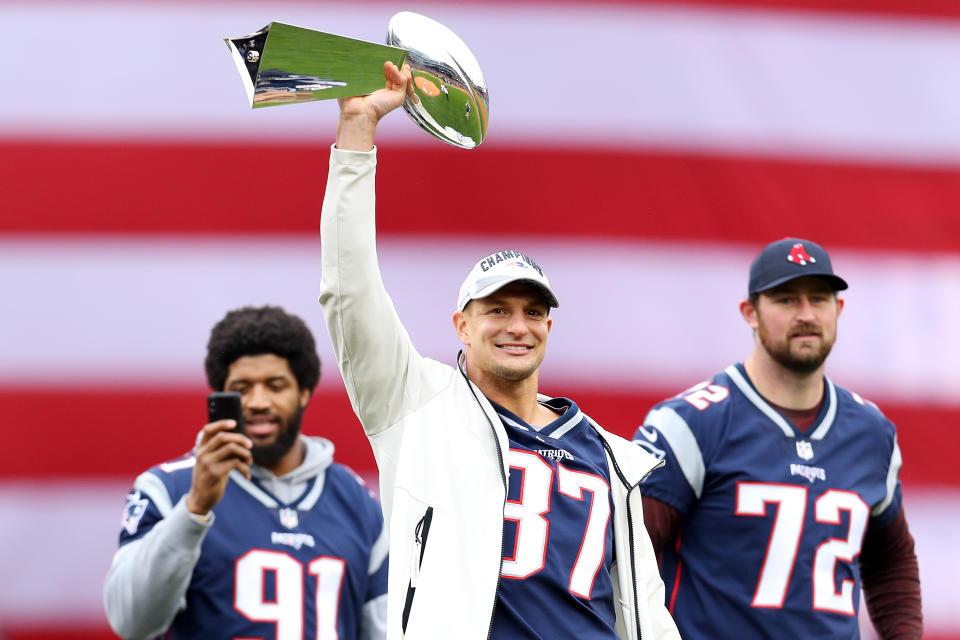How is Rob Gronkowski not a unanimous NFL All-Decade tight end?
Usually it feels like splitting hairs: Guy gets voted to prestigious list or hall. Guy doesn’t get every committee member’s vote. If you’ve been successfully voted in, does it matter if you made it by two votes or 25?
But there are occasions where it’s worth wondering what happened with the voting.
We saw it earlier this year with Derek Jeter’s vote into Cooperstown — the New York Yankees legend was one vote shy of being a unanimous selection.
It caused an uproar in baseball, and as noted by Yahoo Sports colleague Mike Oz, it’s likely that uproar and the social media abuse or worse that would have been directed to the lone dissenter that has led to him or her not revealing themselves.
The NFL All-Decade team for the 2010s isn’t exactly the Hall of Fame, though a player’s placement on one does play a role in whether they’re eventually elected to the Pro Football Hall of Fame.
Among the 55 honorees announced Monday, eight were unanimously voted — Tom Brady, Adrian Peterson, J.J. Watt, among others. But the one player who seems an obvious pick, was not a unanimous vote-getter: former Patriots tight end Rob Gronkowski.
The team was chosen by the 48 members of the Hall of Fame selection committee, and only players who had been named to at least one Pro Bowl, Associated Press All-Pro team or Pro Football Writers of America all-conference team during the 10 seasons were eligible for consideration. Exact vote counts are not released.
Again, Gronkowski did make the team (the Chiefs’ Travis Kelce was the other tight end to make it). And no, the selection committee doesn’t have an easy job.
At most positions.
Gronkowski should have been a slam dunk, or a Gronk Spike, if you prefer.

Gronkowski, listed at 6-foot-6, 270 pounds in his playing days, looked like Ivan Drago. He looked like a player you’d create in Madden, when you had free rein to make the most physically perfect tight end you could think of. He was far too big for cornerbacks to tackle effectively, too fast for most linebackers to keep up with.
Gronkowski played nine seasons in the 2010s, and due to injuries only played 115 of a possible 144 regular-season games. Having had a front-row press box seat for his first five seasons, I can confidently say few players were beat up the way he was and given as little protection. Gronkowski needed back surgery, broke the same arm twice and suffered a torn ACL in 2013 when he took a direct hit to the knee from an opposing defensive back, the type of injury you knew was coming someday from a player desperate to cut him down.
It was the same during the 2011 playoffs, when he suffered multiple torn ankle ligaments on a tackle against the Baltimore Ravens in the AFC championship.
In four of the five seasons in which he played 14 or more games, Gronkowski was voted first-team All-Pro. His tour de force 2011 season saw him set the single-season record for receiving yards and touchdowns by a tight end, with 1,327 and 17, respectively. His 17 touchdowns led the league that season, the first time a tight end had claimed that title. His would-be 18th was ruled a rushing touchdown when Tom Brady’s lateral was deemed behind the line of scrimmage.
His touchdowns set him apart as arguably the best red-zone player ever: 79 receiving touchdowns are third-most all-time at the position, with only Antonio Gates (116) and Tony Gonzalez (111) in front of him. Gates got to that number over 16 seasons, Gonzalez 17.
In all, Gronkowski had four 1,000-yard seasons, totaling 521 catches for 7,861 yards and 80 total touchdowns in the regular season. In a full season’s worth of career playoff games, 16, he had 81 receptions for 1,163 yards and 12 scores.
Beyond the gaudy numbers, Gronkowski could do what many tight ends now don’t: He was stellar as a run blocker, making him a true three-down offensive player. In 2015, the only Patriots player who played more offensive snaps than Brady (98.8 percent) was Gronkowski (84 percent); in his last season, 2018, only Brady and the offensive linemen played more.
And if all of that weren’t enough, just look at the Patriots’ offense last fall, its first without Gronkowski. It was clearer than ever how much of an asset he was.
Oh, and Gronkowski was on the NFL 100 team, among the 100 greatest players in the game’s history.
We don’t want to name and shame the person or persons who left Gronkowski off their all-decade ballot. That’s not cool. But it’s really hard to think there are those who watched the NFL during the 2010s, saw Gronkowski even a handful of times and didn’t think “there’s one of the best tight ends that’s ever played,” let alone the best of the last decade.
More from Yahoo Sports:


